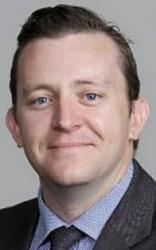
 I had already written this blog before Facebook announced it would be hiring at least 10,000 programmers to start moving the company towards the metaverse. I see the metaverse as one of the next big drivers of increased bandwidth usage. Wikipedia defines the metaverse as a collective virtual shared space created by the convergence of virtually enhanced physical reality and physically persistent virtual space, including the sum of all virtual reality worlds, augmented reality, and the Internet. In the most basic sense, the metaverse consists of online worlds where people interact through avatars. more
I had already written this blog before Facebook announced it would be hiring at least 10,000 programmers to start moving the company towards the metaverse. I see the metaverse as one of the next big drivers of increased bandwidth usage. Wikipedia defines the metaverse as a collective virtual shared space created by the convergence of virtually enhanced physical reality and physically persistent virtual space, including the sum of all virtual reality worlds, augmented reality, and the Internet. In the most basic sense, the metaverse consists of online worlds where people interact through avatars. more
 I’ve lately been looking at broadband policies that have shaped broadband, and I don’t think there has been any more disastrous FCC policy than the one that defines broadband by speed. This one policy has led to a misallocation of funding and getting broadband to communities that need it. The FCC established the definition of broadband as 25/3 Mbps in 2015, and before then, the definition of broadband was 4/1 Mbps, set a decade earlier. The FCC defines broadband to meet a legal requirement established by Congress and codified in Section 706 of the FCC governing rules. more
I’ve lately been looking at broadband policies that have shaped broadband, and I don’t think there has been any more disastrous FCC policy than the one that defines broadband by speed. This one policy has led to a misallocation of funding and getting broadband to communities that need it. The FCC established the definition of broadband as 25/3 Mbps in 2015, and before then, the definition of broadband was 4/1 Mbps, set a decade earlier. The FCC defines broadband to meet a legal requirement established by Congress and codified in Section 706 of the FCC governing rules. more
 An industry group calling itself 5G Americas has published a whitepaper that touts the advantages of a smart auto grid powered by 5G and the C-V2X technology. This technology is the car connectivity standard that much of the industry has gelled around, replacing the older DSRC standard. Over a decade ago, the FCC became so enamored over the idea of self-driving cars that the agency dedicated the 5.9 GHz spectrum band for the sole use of smart cars. more
An industry group calling itself 5G Americas has published a whitepaper that touts the advantages of a smart auto grid powered by 5G and the C-V2X technology. This technology is the car connectivity standard that much of the industry has gelled around, replacing the older DSRC standard. Over a decade ago, the FCC became so enamored over the idea of self-driving cars that the agency dedicated the 5.9 GHz spectrum band for the sole use of smart cars. more
 It was only a few weeks back, in July of this year, where I remarked that an Akamai report of an outage was unusual for this industry. It was unusual in that it was informative in detailing their understanding of the root cause of the problem, describing the response that they performed to rectify the immediate problem, the measures being undertaken to prevent a recurrence of this issue, and the longer-term measures to improve the monitoring and alerting processes used within their platform. more
It was only a few weeks back, in July of this year, where I remarked that an Akamai report of an outage was unusual for this industry. It was unusual in that it was informative in detailing their understanding of the root cause of the problem, describing the response that they performed to rectify the immediate problem, the measures being undertaken to prevent a recurrence of this issue, and the longer-term measures to improve the monitoring and alerting processes used within their platform. more
 Huawei's Cloud is growing faster than Amazon, Microsoft, or Google, Iain Morris writes. He cites U.S. Senator Tom Cotton on growth in "Egypt, Indonesia, Malaysia, Mexico, Saudi Arabia, Turkey, and the United Arab Emirates." Cotton further says: "In addition, Huawei's cloud services revenues reportedly rose by almost 170 percent in 2020. This accelerating revenue stream threatens to undermine U.S. efforts to curtail Huawei's power, influence, and financial strength." I think Cotton is a little high on Huawei Cloud growth... more
Huawei's Cloud is growing faster than Amazon, Microsoft, or Google, Iain Morris writes. He cites U.S. Senator Tom Cotton on growth in "Egypt, Indonesia, Malaysia, Mexico, Saudi Arabia, Turkey, and the United Arab Emirates." Cotton further says: "In addition, Huawei's cloud services revenues reportedly rose by almost 170 percent in 2020. This accelerating revenue stream threatens to undermine U.S. efforts to curtail Huawei's power, influence, and financial strength." I think Cotton is a little high on Huawei Cloud growth... more
 Last year we had terrible DSL from Consolidated Communications and much better, although not always consistent, service from wireless ISP GlobalNet. I signed up for fiber service from Stowe Cable for installation this year and also was accepted early as a Beta tester for Starlink. Now we have both Starlink and fiber and can compare the two. I was very happy to cancel my Consolidated service but felt bad about canceling GlobalNet, which was essential to me for many years. Most of the time, there are only two of us in the house. more
Last year we had terrible DSL from Consolidated Communications and much better, although not always consistent, service from wireless ISP GlobalNet. I signed up for fiber service from Stowe Cable for installation this year and also was accepted early as a Beta tester for Starlink. Now we have both Starlink and fiber and can compare the two. I was very happy to cancel my Consolidated service but felt bad about canceling GlobalNet, which was essential to me for many years. Most of the time, there are only two of us in the house. more
 As I noted on May 26, the final decision issued on May 20 in the Independent Review Process (IRP) brought by Afilias against the Internet Corporation for Assigned Names and Numbers (ICANN) rejected Afilias’ petition to nullify the results of the public auction for .WEB, and it further rejected Afilias’ demand to have it be awarded .WEB (at a price substantially lower than the winning bid). Instead, as we urged, the IRP Panel determined that the ICANN Board should move forward with reviewing the objections made about .WEB, and to make a decision on delegation thereafter. more
As I noted on May 26, the final decision issued on May 20 in the Independent Review Process (IRP) brought by Afilias against the Internet Corporation for Assigned Names and Numbers (ICANN) rejected Afilias’ petition to nullify the results of the public auction for .WEB, and it further rejected Afilias’ demand to have it be awarded .WEB (at a price substantially lower than the winning bid). Instead, as we urged, the IRP Panel determined that the ICANN Board should move forward with reviewing the objections made about .WEB, and to make a decision on delegation thereafter. more
 Last month, the Sustainable Digital Infrastructure Alliance (SDIA) announced our Open Data Hub, a resource that's meant to boost transparency, trust, and data availability to help researchers, industry, and society realize a sustainable digital economy. It is essentially our answer to the challenge recognized across the sector: that the lack of reliable data is one of the most foundational issues we face in creating a sustainable ICT ecosystem. more
Last month, the Sustainable Digital Infrastructure Alliance (SDIA) announced our Open Data Hub, a resource that's meant to boost transparency, trust, and data availability to help researchers, industry, and society realize a sustainable digital economy. It is essentially our answer to the challenge recognized across the sector: that the lack of reliable data is one of the most foundational issues we face in creating a sustainable ICT ecosystem. more
 A substantial amount of DNS community discussion on the topic of DNS Abuse is focused on defining what is or is not DNS Abuse. The definition adopted by ICANN contracted parties, as well as the DNS Abuse Institute, is straightforward: DNS Abuse is malware, botnets, pharming, phishing, and spam where it's a vehicle for the preceding harms. There is, of course, some fuzziness on the margins, where technical harms are also using content. more
A substantial amount of DNS community discussion on the topic of DNS Abuse is focused on defining what is or is not DNS Abuse. The definition adopted by ICANN contracted parties, as well as the DNS Abuse Institute, is straightforward: DNS Abuse is malware, botnets, pharming, phishing, and spam where it's a vehicle for the preceding harms. There is, of course, some fuzziness on the margins, where technical harms are also using content. more
 For the past few decades, there's been a relatively straightforward narrative on the economics behind the IPv6 transition that goes something like this: sooner or later, IPv4 scarcity will drive costs up until they exceed those of deploying IPv6. A competitive market will then make the rational choice and transition to a more efficient mode of production and deploy IPv6. This is textbook economics, and - with the disclaimer that I'm not a trained economist - it appears to be incorrect. more
For the past few decades, there's been a relatively straightforward narrative on the economics behind the IPv6 transition that goes something like this: sooner or later, IPv4 scarcity will drive costs up until they exceed those of deploying IPv6. A competitive market will then make the rational choice and transition to a more efficient mode of production and deploy IPv6. This is textbook economics, and - with the disclaimer that I'm not a trained economist - it appears to be incorrect. more
 At ICANN's recent virtual meeting, I was fortunate enough to join a panel facilitated by the Brand Registry Group (BRG), an association of organisations promoting the use of brand top-level domains, where we discussed the release of the next round of the generic top-level domain (gTLD) program. The fact that I was participating in a discussion like this is hardly news, as I've been commenting on the policy discussions and debating its role in the digital landscape for years. more
At ICANN's recent virtual meeting, I was fortunate enough to join a panel facilitated by the Brand Registry Group (BRG), an association of organisations promoting the use of brand top-level domains, where we discussed the release of the next round of the generic top-level domain (gTLD) program. The fact that I was participating in a discussion like this is hardly news, as I've been commenting on the policy discussions and debating its role in the digital landscape for years. more
 In recent times, groups of people gather at the ITU in Geneva and write a "strategic plan" covering the next few years. Indeed, there is a current questionnaire to that effect. It is frozen in a world that existed 30 years ago, and by any measure, surreal and absurd. It needs to be terminated. Here is why. The International Telecommunication Union (ITU) has existed in various forms since 1850 to perform two basic functions. more
In recent times, groups of people gather at the ITU in Geneva and write a "strategic plan" covering the next few years. Indeed, there is a current questionnaire to that effect. It is frozen in a world that existed 30 years ago, and by any measure, surreal and absurd. It needs to be terminated. Here is why. The International Telecommunication Union (ITU) has existed in various forms since 1850 to perform two basic functions. more
 On Sunday, July 11, thousands of Cubans, took to the streets in anti-government protests triggered by COVID, the faltering economy, and an overwhelmed healthcare system. In three days, 110 protests took place across the island. The following is a snapshot of an interactive, crowd-sourced map showing the locations of 118 large and small demonstrations (94 reported on the 11th, 14 on the 12th, seven on the 13th and three on the 17th). more
On Sunday, July 11, thousands of Cubans, took to the streets in anti-government protests triggered by COVID, the faltering economy, and an overwhelmed healthcare system. In three days, 110 protests took place across the island. The following is a snapshot of an interactive, crowd-sourced map showing the locations of 118 large and small demonstrations (94 reported on the 11th, 14 on the 12th, seven on the 13th and three on the 17th). more
 Last week, I predicted that much of the Internet and most cloud datacenters would launch into space in the next ten years. Today the only part of the Internet in space is a very small amount of "bent-pipe" access: signals which go from a user to a satellite and bounce back down to a ground station which feeds them into the terrestrial internet where all processing is done and all queries answered by internet-connected servers, many of them in cloud data centers. more
Last week, I predicted that much of the Internet and most cloud datacenters would launch into space in the next ten years. Today the only part of the Internet in space is a very small amount of "bent-pipe" access: signals which go from a user to a satellite and bounce back down to a ground station which feeds them into the terrestrial internet where all processing is done and all queries answered by internet-connected servers, many of them in cloud data centers. more
 Over two years ago, an MIT research group ran a simulation of the low-Earth orbit broadband constellations of OneWeb, SpaceX, and Telesat, and last January they repeated the simulation updating with revised constellation characteristics and adding Amazon's Project Kuiper. They ran the new simulation twice, once using the planned initial deployments of each constellation and a second time using the configuration shown. more
Over two years ago, an MIT research group ran a simulation of the low-Earth orbit broadband constellations of OneWeb, SpaceX, and Telesat, and last January they repeated the simulation updating with revised constellation characteristics and adding Amazon's Project Kuiper. They ran the new simulation twice, once using the planned initial deployments of each constellation and a second time using the configuration shown. more